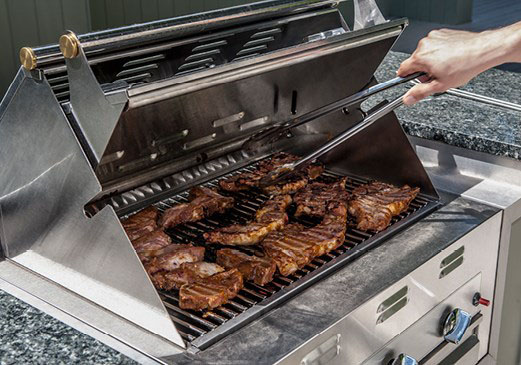Gas grill BTU 101: How many BTUs do you need for a grill
When it comes to buying the right propane grill, bigger isn’t necessarily better. Other key factors can have a large influence on how efficiently your grill creates heat. Among the biggest contributing factors are BTUs.
What are BTUs in grills? What is a BTU rating?
Propane appliances, including grills, are typically rated by their energy output capacity, measured in BTUs, or British Thermal Units. Each BTU is the amount of thermal energy required to raise the temperature of one pound of water by one degree Fahrenheit. And while that’s a great metric for determining the right size heater for your home, when it comes to outdoor cooking surface area is more important than maximum heating capacity.
How many BTUs do I need in a grill?
The question always emerges “how many BTUs do I need for a grill?” The answer is less a matter of gas grill BTU ratings, and more a matter of the primary cooking area, and the BTUs per square inch.
Standard BTU Range for a grill
The industry standard for BTUs needed for a grill is between 75 and 100 BTUs per square inch of heating surface. When choosing a grill, shoppers should focus on the quality of construction, the desired cooking area, and the ability to generate even heating across the entire cooking surface.
Grills that fall in the lower range, and specifically below 71 BTUs per square inch, could operate at lower temperatures and result in longer cooking times. Conversely, a grill above 100 BTUs per square inch could generate too much heat and potentially char your meal. Typically, a grill with between 80 to 100 BTUs per square inch of cooking surface will provide fast and consistent heat.
PRO TIP: THE BTU RATING SHOULD APPLY TO THE GRILLING SURFACE
It’s important to make sure that the BTU rating listed on the grill applies to the grilling surface. Some manufacturers try to boost the BTU rating by including the output for side burners, or accessory heating elements.
To find your grilling surface BTUs, follow this formula:
TOTAL BTUS FOR THE MAIN BURNER
__________________________________________________________
THE PRIMARY COOKING AREA IN SQUARE INCHES
While this might bring the total BTU to within the optimal range, 75-100 BTUs, it could lead to under heating of the primary cooking surface that lacks the ability to meet your demands. A quality grill will give you years of trouble-free use, and use the right amount of propane to meet your grilling needs.
PRO TIP: AVOID EXCESSIVE BTU RATINGS
Additionally, an excessive BTU rating on a propane grill might be an effort to compensate for poor craftsmanship. Inspect grills carefully before making your purchase. Look for models that have heavy-duty lids that seal tightly around the primary cooking area. Grills with high-quality grates for the cooking surface, and well-constructed vents that can help control airflow, will produce better results for your backyard barbecue.

Number of BTUs in a Grill & Propane Use
Determining how long a 20-pound propane tank might last depends on a number of variables, including the construction and efficiency of your grill, the heat setting, and the amount of time in use.
A standard sized 20-pound propane cylinder holds approximately 430,000 BTUs of liquid propane. Each gallon of propane contains 91,502 BTUs of potential heat and each pound contains approximately 21,548 BTUs.
A full 20-pound tank on a grill with 30,000 BTU maximum output on medium heat should yield between 19 and 20 hours of cooking time.
While propane grills have long been popular appliances for outdoor grilling because of their instant heat and even temperature control, another popular option is an infrared propane grill.
TRY AN INFRARED GRILL FOR HIGHER EFFICIENCY
Unlike conventional propane grills that rely on an open flame to heat the cooking grates, infrared grills employ a conductive element that radiates heat upward to the cooking surface. As such, they can operate effectively at a lower BTU rating - generally between 60 and 80 BTUs per square inch of surface. Those who prefer infrared grills argue the system perfectly sears meat, offers uniform heat, as well as reduced flare-ups from drippings from the cooking surface.
The benefits of choosing a propane grill over charcoal or natural gas
Finding the right propane grill might be the hardest part of preparing for your backyard endeavors, because propane is:
- among the safest, easiest, and enjoyable ways to cook outdoors
- instantly on and ready for use, without the danger and messiness of charcoal
- can be moved to fit your changing needs. They don’t require permanent fixtures and piping like natural gas
Fuel your grill with propane from Ferrellgas and Blue Rhino
Thanks to the wide network of Ferrellgas locations and Blue Rhino tank exchange stations, the fire behind your next cookout is never far away.
CATEGORIES
Archives
- Summer 2025
- Spring 2025
- Winter 2024
- Fall 2024
- Summer 2024
- Spring 2024
- Winter 2023
- Fall 2023
- Summer 2023
- Spring 2023
- Winter 2022
- Fall 2022
- Summer 2022
- Spring 2022
- Winter 2021
- Fall 2021
- Summer 2021
- Spring 2021
- Winter 2020
- Fall 2020
- Summer 2020
- Spring 2020
- Winter 2019
- Fall 2019
- Summer 2019
- Spring 2019
- Winter 2018
- Fall 2018
- Summer 2018
- Spring 2018
- Winter 2017
